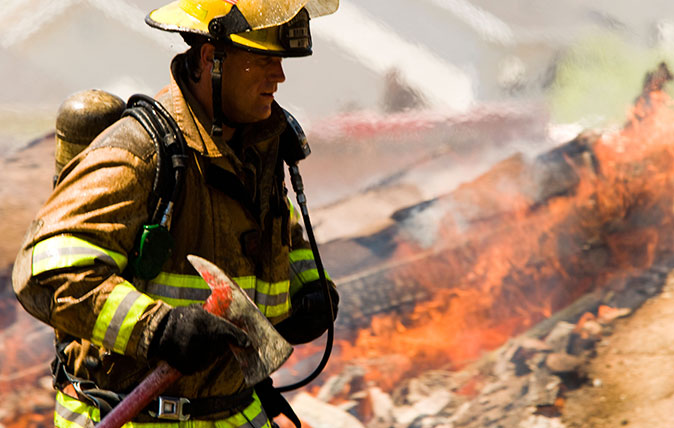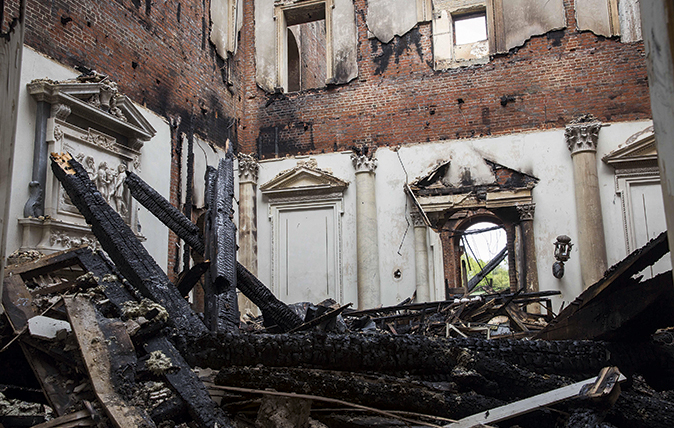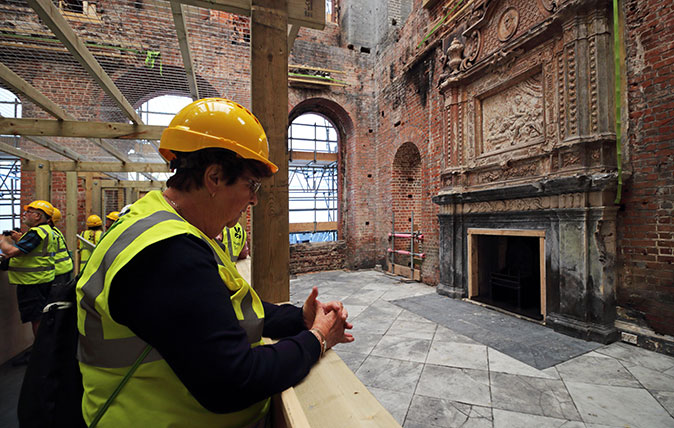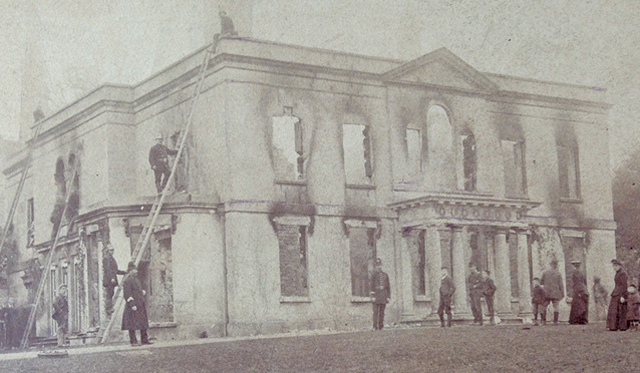How to fireproof your country house
Just thinking about it is enough to get any country-house owner hot under the collar, but when it comes to fire, prevention is key.

One November night in 2012, Graeme Hart received the phonecall that every house owner dreads. The family home, 17th-century Sydenham House in Devon, was on fire. Rushing back, he saw the sky illuminated for miles around. Flames were leaping through the roof, above which stood firemen on turntables directing water jets—the whole spectacle was watched by a crowd of about 100. Within 12 hours, the Grade I-listed property had been reduced to a blackened shell.
Throughout history, fire has been the great scourge of the country house. When Clandon Park in Surrey, owned by the National Trust, burnt in April 2015, it became the latest of many high-profile casualities, whose tally includes Uppark House in West Sussex, Windsor Castle and Hampton Court.

The good news is that all these examples have—or will be—rebuilt and Sydenham has also risen from the ashes in an exemplary restoration that Country Life will describe later this year.
Why are country houses so vulnerable to fire?
Robert Hiscox, Honorary President of Hiscox, the Lloyd’s of London underwriter, has more knowledge of fires than most. ‘In the old days, houses were eternally damp, particularly so during the winter. Central heating turns them into tinder boxes.’ All it took at Sydenham was for a low winter sun to shine through a west-facing bathroom onto a shaving mirror, which then directed the light onto a curtain or towel.
Country houses are particularly vulnerable because of their isolation; a fire may not be noticed until too late. ‘Ask a friend or neighbour to check on your property when you’re on holiday,’ advises Chris Lovett of insurance broker Lycetts. It’s also important to make sure that the Fire Brigade can get access and know where to find water—a pond or swimming pool may be the answer.
Fortunately, no life was lost at Sydenham, but that's not always the case. ‘Fire extinguishers aren’t there to enable you to put out a fire,’ says Mr Hiscox. ‘They’re to help you get out of the house.’
It isn't just the fire you need to worry about
Not long ago, architect John Simpson suffered damage to his semi-detached country cottage. ‘A neighbour rang up saying that smoke was coming out of the roof and the Fire Brigade had been called. What did we want to save?’ Like other fire-stricken owners, he felt ‘‘completely helpless’.
Exquisite houses, the beauty of Nature, and how to get the most from your life, straight to your inbox.
The cause of that fire was a metal chimney liner that his neighbour had attached to a new stove; the heat ignited the thatched roof. Although the fire itself did little damage to the Simpsons’ property, the water directed onto it by the fire team made the place uninhabitable.

Readers of Hilaire Belloc’s poem Matilda will remember the pains taken by London’s Noble Fire-Brigade to ‘souse The Pictures up and down the House’. Water is still one of the great destroyers of historic buildings, not least because it wrecks injected damp-proof courses, which need replacing. The flooding of wine cellars can be a cruel blow to owners, deprived of the convivial store at the very time that they are most in need of cheering up.
Private owners may avoid sprinkler systems as they're likely to be more trouble than they’re worth, but there are now improved examples that either extinguish fires through the release of inert gas or direct a mist solely towards the seat of the fire rather than spraying water indiscriminately in all directions.
Common causes of house fires
Few fires are now caused by cigarettes smoked in bed and it may be that the fashion for tea lights, left burning around kitchens or bathrooms, with the risk that pieces of paper could blow onto them, is past, too. Instead, living areas and, worse, bedrooms are packed with electronic devices: televisions that rise from the bottom of the bed, curtains that are opened from a control panel, phone chargers, hair straighteners and so on.
According to NFU Mutual, electrical faults were the commonest cause of fire in the first three-quarters of 2016. More fires now start on upper floors than before and they are particularly dangerous when the family is asleep (so fit smoke detectors in bedrooms as well as corridors).
‘One thing that will increase the potential for electrical fire is an over-loaded plug socket,’ advises Nathan Brew, the NFU Mutual’s Property Technical Manager. ‘Remove all extension blocks and put them safely in the bin. If you need more plug sockets, have extra outlets installed.’
Fortunately, the temptation of the old pop-up fuses, which could be mended with hair pins, has gone and LED lights are cooler than incandescent bulbs, yet it only takes one mouse to nibble through an attic wire to cause devastation. Make sure that wiring isn't vulnerable to rats, squirrels and other vermin.
Employ trustworthy tradesmen
According to Mr Hiscox, ‘builders have wrecked more of Britain’s historic houses than the Luftwaffe’. Certainly, Tim Moulding of long-established Wiltshire building firm R. Moulding & Co is well aware of the danger posed during restoration. ‘Skip fires can be devastating—they must be sited safely away from the building. Tradesmen must extinguish their cigarettes in a sand bucket, not throw them into a skip. Also, burning off paint from sliding sash windows is a huge risk and must be done with extreme care.’
Owners who are about to embark on a project might want to seek advice on whether to take out a joint-names insurance policy with the builder. This can avoid the client suffering agonising delays, on top of the hurt caused by the fire.

Keep your chimney sweep on speed dial
Open fires are delightful, but, sadly, they're responsible for almost as many conflagrations as electrical faults. It’s essential that chimneys are swept annually, lest twigs in birds’ nests slip down to become charcoal that gets blown out into a room.
However, take hope—not all is bad. There are fewer fires than there used to be, ‘sniffer’ fire alarms are more sophisticated than smoke and heat detectors and healthy eating means fewer chip pans—a regular cause of disaster in previous generations.
And if the worst happens? Although fires often come at appalling personal cost, in terms of the loss of possessions and memories, owners can comfort themselves with the thought that specialist firms can salvage more than any ordinary person would think possible. In the case of a listed building, the arrangement of rooms may become more convenient for modern life.

Fire avoidance tips
Hugh Petter of ADAM Architecture suggests:
- Install lightning conductors, especially if the house is exposed
- Get the wiring checked regularly. If replacing cables, consider putting them in metal trunking to protect them from rodents
- Watch out for incandescent light bulbs. They can get very hot and material shades can catch fire, particularly if too bright a bulb is used or if the shade is old and damaged. Lightbulbs can also ignite curtains if too close
- Be careful when applying oil to a floor. Rags soaked in some oils can combust spontaneously if left scrunched up
- Fires can be contained for longer if there are fire breaks installed to compartmentalise the building. This will need specialist advice from an architect, building surveyor or fire engineer
- Install and maintain a proper fire-detection system to ensure that all occupants get early warning of a problem. Specialist firms can help
- Some people think they are being very clever when they get building- regulation approval for work and then remove fire doors and self-closing devices to give them the interior space they want. However, if there is a fire, they may find they’re not properly insured. Be candid about what you want at the design stage and it may be possible to find a way around the problem that remains safe
Keep the home fires burning, but safely
Tips for log fires from Nathan Brew of NFU Mutual
- Only use well-seasoned wood and keep log stores away from the house, not under the porch and near those very hot halogen lights that welcome guests
- Good-quality liners should be used for any chimneys in use, particularly where a wood-burning stove generates high temperatures. (It’s worth fitting a flue thermometer—they’re not expensive.) Older properties will have very robust masonry materials on the lower levels, but upper floors may have lighter and more combustible lathe-and-plaster walling/ceilings
- Consider chimney inspections using mini cameras to look for damage and missing bricks
- Any iron back plates behind open fires should be fixed to the wall to prevent them toppling. A full open fire will be thrown out into the lounge if a back plate falls over onto it
- In addition, owners should check that their fire guards have a sufficiently fine mesh to stop sparks getting through and keep loose rugs with fringes well aware from the fire. Boiler rooms should not be used for drying wet but combustible coats
